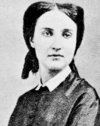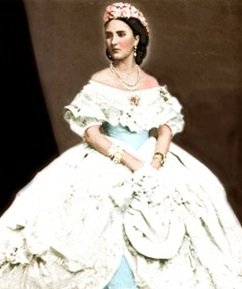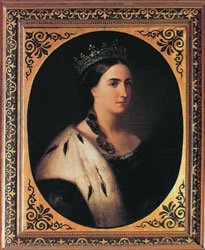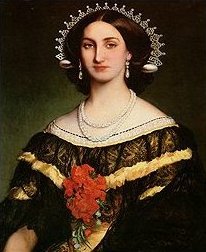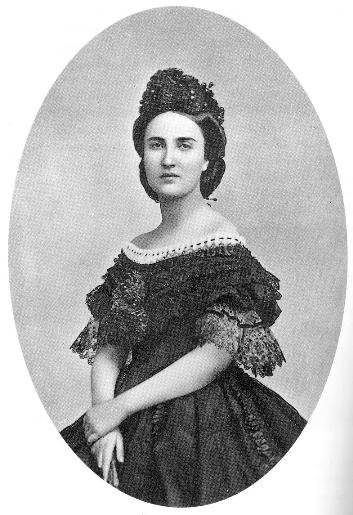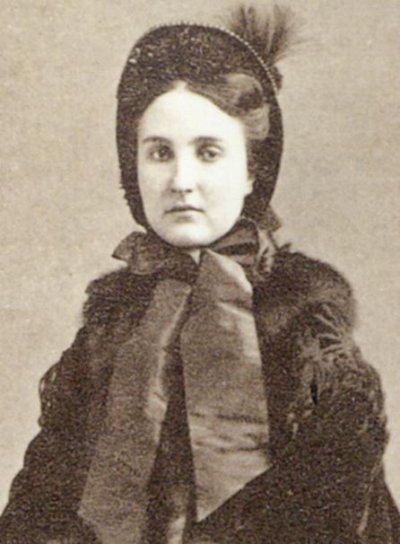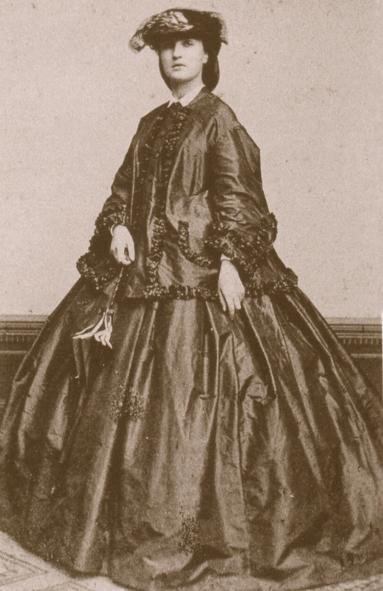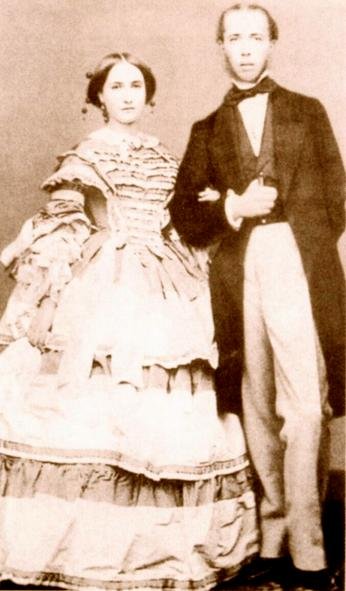EtienneDuchessofBurgundy
Gentry
- Joined
- Aug 13, 2003
- Messages
- 54
Empress Charlotte "Carlota"
Charlotte of Belgium
Archduchess of Austria - Empress of Mexico
She was the daughter of Leopold of Saxe-Coburg-Gotha, born in 1840. Charlotte, as she was known before becoming Empress of Mexico, was charming, attractive and beautiful with her black hair, dark-brown eyes and slender figure. She was also intelligent, serious, dutiful and energetic and her behaviour was always dignified. At the age of 13, she already read Plutarch..
Charlotte of Belgium was only 10 years old, when her mother died and it marked the end of her childhood. In 1853 her brother Leopold (1835-1909) married the Habsburg Princess Marie Henriëtte (1836-1902). In the summer of 1856 the 24-year-old Habsburg Archduke Maximilian, a brother of the Austrian Emperor Francis Joseph, visited Brussels. Charlotte fell hopelessly in love with him. Maximilian asked Leopold I for the hand of his daughter and, although Leopold I preferred Pedro V of Portugal as son-in-law, he allowed 16-year-old Charlotte to make her own choice. On his second visit to Brussels, Maximilian talked with Charlotte about his liberal, idealistic and Byronic ideas. He showed her the drawings for the villa Miramar, being build in medieval style near Triëst, and fascinated her with the stories of his travels to exotic places.
Emperor Maximilian
The negotiations about the dowry dragged on for some time, but on July 27, 1857, 17-year-old Charlotte married Maximilian. Afterwards they travelled via Vienna to Italy, because Maximilian had been appointed as viceroy of Lombardy and Venice. They were coolly received in Milan, but Charlotte was enchanted when she saw Venice, and she wrote enthusiastic letters to Brussels. In 1859 the Italian War of Freedom broke out and Maximilian and Charlotte were forced to flee. Later that year there was true roomers about he having an affair, and since they slept in different bedrooms. Even then they remained friends and appeared as a doting couple to the outside world. Residing in the villa Miramar, Charlotte read books, wrote, painted, swam and sailed, but she was bored and longed to be useful.
In 1863 Napoleon III of France offered the crown of Mexico to Maximilian. He hesitated. Charlotte, however, longed for a vocation and pushed him to accept the proposal. A group of wealthy, conservative Mexicans convinced them that the people of Mexico wanted him as their Emperor. After Napoleon III had promised that he would "never let the new empire down", Maximilian signed the agreement. Charlotte's French grandmother, Marie Amélie (1782-1866), shrieked: "They will be killed! They will be killed!". In contrast, all Charlotte's Coburg relatives seem to have been blinded by the glitter of the Imperial Crown. When the Austrian Emperor Francis Joseph declared that Maximilian had to give up his rights to the Austrian throne on accepting the Mexican Crown, Maximilian again hesitated. Charlotte tried to negotiate with Francis Joseph, but he did not give in, thus Charlotte convinced Maximilian to renounce his rights to the Austrian throne. Then Charlotte changed her name to 'Carlota' and started organising their departure.
They had left Austrian soil on April 14, 1864, and arrived in Mexico on May 24, where they were coolly received. In Mexico City the ramshackle Palacio National resembled barracks, so they moved to castle of Chapultepec. Mexico was nearly bankrupt and their position was precarious. The Mexican conservatives supported Maximilian, who had liberal ideas, while the liberals preferred the elected president, Benito Juárez (1806-1872), whose followers were conducting a guerrilla war against the French troops. When Maximilian decreed a guarantee of the freedom of religion, he antagonised the papal nuncio, too, and as a result the pope withdrew his support in the spring of 1865. That year the American Civil War ended. The United States opposed to the French troops in Mexico and supported Juárez. To make things worse, Maximilian could not get along with the French supreme commander in Mexico. He travelled through the country, desperately trying to win over the Mexican people. Charlotte ruled in his absence and, even when he was present, she often drew up official documents for him. Despite their professional co-operation, the couple continued to sleep in separate bedrooms and Maximilian often shared his bedroom with other women. One of them was the 17-year-old Concepción Sedano y Leguizano, who gave birth to a son. Since Maximilian did not have any prospect of begetting a legitimate heir, he decided to adopt a grandson of a former Mexican Emperor, Agustin de Itúrbide (1783-1824). The boy's mother soon regretted the arrangement and started proclaiming loudly throughout France that Maximilian "had stolen her son from her".
Early 1866, Napoleon III refused to give Maximilian any further financial support, despite his earlier promise. As a result of American pressure and his fear of Prussian aggression, Napoleon also announced the withdrawal of his troops from Mexico. Earlier Charlotte had received the news of her father's death and now she became nervous and depressed. However, when Maximilian contemplated his abdication, Charlotte refused to give up and, despite the raining season, she decided to travel to Europe to reason with Napoleon III. She arrived in France on August 8, 1866 and received a telegram from Napoleon III informing her of his illness. Charlotte nevertheless travelled to Paris and moved into the Grand Hôtel. The next day the Empress Eugénie, Napoleon's Spanish wife, visited her and through Eugénie's mediation, Charlotte was later received by Napoleon III. She described her plan how to save the Mexican Empire, but Napoleon and his councillors were unrelenting. During their second meeting, Charlotte became terribly upset and began to cry hysterically. In their third and final conversation Napoleon told her that the withdrawal of the French troops was final.
In her letter to Maximilian, Charlotte wrote that Napoleon III represented "the evil on earth" and that he was "possessed by the devil". Friends commented on her strange behaviour. While she was travelling from Paris to Triëst, she told her lady-in-waiting that she had identified a farmer in the field as an assassin. She ordered the coachman to increase speed and held an handkerchief in front of her face during the remainder of the ride. In the villa Miramar a courier arrived from Mexico with bad news and a request from Maximilian to ask the pope for help. Thus, Charlotte left for Rome, and had two meetings with the pope. Then, one morning, she burst into the pope's apartments, kneeled before him and screamed that her staff tried to poison her: "All food they give me contains poison and I am starving". That day she insisted on spending the night in the Vatican and the astonished pope had a bed prepared in the library. Officially, it was the only time ever that a woman stayed a night in the Vatican. The next day, the mother superior of a nearby convent persuaded Charlotte to visit an orphanage. With an handkerchief in front of her face Charlotte travelled in her coach to the convent, where she held a charming speech. Afterwards, she was lead about the convent and in the kitchen she snatched a piece of meat from a hot pan. She burned her hand, fainted from the pain and was hurried off to her hotel. When she was thirsty, she took the pope's glass and walked with it to a public fountain. Her relatives were informed of her condition and soon her brother Philip arrived and escorted her to Triëst.
From then on Charlotte was confined to Miramar by Maximilian's relatives and no one was allowed to visit her. As a result of the quietness and good food, her physical health improved and she was as beautiful as ever, but apparently her behaviour remained strange. She was not invited for the marriage of her brother Philip in May. Charlotte occupied herself with reading books and writing letters. As a result of her long seclusion at Miramar, rumours started that she had been pregnant, when she left Mexico, and had given birth at Miramar early 1867. Some even tried to identify the child as Maxime Weygand, while other rumours said that this man was a son of Charlotte's brother, Leopold II. In any case, it is highly unlikely that the proud, dutiful and unapproachable Empress Charlotte would have taken a lover.
Early 1867 the French troops were withdrawn from Mexico and Maximilian cabled his family in Vienna that he would soon return home. His family underestimated the seriousness of the situation in Mexico and his mother, Sophie of Bavaria, wrote firmly: "I must still wish that you hold out in Mexico as long as you can with honour do so." Thus, when the supporters of Juárez advanced on Mexico City, Maximilian retreated to Querétaro. With only a small army of supporters, he met Juárez in battle, was quickly defeated, captured and sentenced to death. Many distinguished European liberals, like Victor Hugo and Giuseppe Garibaldi, took pity on the naive and well-meaning Emperor and petitioned Juárez to spare his life. On the morning of June 19, 1867, however, Maximilian was led out on the hill near Querétaro. He presented each man on the firing squad with a gold piece, asking them to aim carefully at his heart. Nevertheless, the first salvo did not kill him, and one of the bullets pierced his face. The second salvo was deathly.
Marie Henriëtte, the sister-in-law that Charlotte had always loathed, travelled in the summer of 1867 to Miramar, to escort Charlotte to Belgium. In the Palace of Laken the ex-Empress happily lived amongst her relatives until the summer of 1868, when she was suddenly overcome by fits of frenzy and confined to castle Tervuren. During the winter she was back in Laken, but in the spring of 1869 her condition worsened and from then on Charlotte was to remain in castle Tervuren. She laughed, wept, held monologues and talked incoherently, but she had still many lucid periods, when she behaved dignified, gave perfectly normal answers to questions, read books, painted or played the piano. She was always concerned about her appearance and she was still a beauty.
In March 1879 the castle was on fire. Charlotte was tied to her carriage with a shawl and brought to Laken. After a few weeks she was confined to castle Bouchout. There, her condition worsened and in attacks of frenzy she smashed the furniture, broke vases, tore up books and cut up paintings. Strangely, she never damaged possessions that reminded her of Maximilian. King Leopold II never visited his sister at Bouchout, but Queen Marie Henriëtte and her daughters did. Princess Stephanie writes in her memoirs that even as a child she was never afraid of her Aunt Charlotte. During World War I the German Emperor decreed that castle Bouchout was not to be disturbed, because Charlotte was the sister-in-law of his ally, the Austrian Emperor. It was not until January 19, 1927, that Charlotte died of pneumonia at the age of 86.
http://www.fortunecity.com/victorian/dadd/...58/Carlota.html
Charlotte of Belgium
Archduchess of Austria - Empress of Mexico
She was the daughter of Leopold of Saxe-Coburg-Gotha, born in 1840. Charlotte, as she was known before becoming Empress of Mexico, was charming, attractive and beautiful with her black hair, dark-brown eyes and slender figure. She was also intelligent, serious, dutiful and energetic and her behaviour was always dignified. At the age of 13, she already read Plutarch..
Charlotte of Belgium was only 10 years old, when her mother died and it marked the end of her childhood. In 1853 her brother Leopold (1835-1909) married the Habsburg Princess Marie Henriëtte (1836-1902). In the summer of 1856 the 24-year-old Habsburg Archduke Maximilian, a brother of the Austrian Emperor Francis Joseph, visited Brussels. Charlotte fell hopelessly in love with him. Maximilian asked Leopold I for the hand of his daughter and, although Leopold I preferred Pedro V of Portugal as son-in-law, he allowed 16-year-old Charlotte to make her own choice. On his second visit to Brussels, Maximilian talked with Charlotte about his liberal, idealistic and Byronic ideas. He showed her the drawings for the villa Miramar, being build in medieval style near Triëst, and fascinated her with the stories of his travels to exotic places.
Emperor Maximilian
The negotiations about the dowry dragged on for some time, but on July 27, 1857, 17-year-old Charlotte married Maximilian. Afterwards they travelled via Vienna to Italy, because Maximilian had been appointed as viceroy of Lombardy and Venice. They were coolly received in Milan, but Charlotte was enchanted when she saw Venice, and she wrote enthusiastic letters to Brussels. In 1859 the Italian War of Freedom broke out and Maximilian and Charlotte were forced to flee. Later that year there was true roomers about he having an affair, and since they slept in different bedrooms. Even then they remained friends and appeared as a doting couple to the outside world. Residing in the villa Miramar, Charlotte read books, wrote, painted, swam and sailed, but she was bored and longed to be useful.
In 1863 Napoleon III of France offered the crown of Mexico to Maximilian. He hesitated. Charlotte, however, longed for a vocation and pushed him to accept the proposal. A group of wealthy, conservative Mexicans convinced them that the people of Mexico wanted him as their Emperor. After Napoleon III had promised that he would "never let the new empire down", Maximilian signed the agreement. Charlotte's French grandmother, Marie Amélie (1782-1866), shrieked: "They will be killed! They will be killed!". In contrast, all Charlotte's Coburg relatives seem to have been blinded by the glitter of the Imperial Crown. When the Austrian Emperor Francis Joseph declared that Maximilian had to give up his rights to the Austrian throne on accepting the Mexican Crown, Maximilian again hesitated. Charlotte tried to negotiate with Francis Joseph, but he did not give in, thus Charlotte convinced Maximilian to renounce his rights to the Austrian throne. Then Charlotte changed her name to 'Carlota' and started organising their departure.
They had left Austrian soil on April 14, 1864, and arrived in Mexico on May 24, where they were coolly received. In Mexico City the ramshackle Palacio National resembled barracks, so they moved to castle of Chapultepec. Mexico was nearly bankrupt and their position was precarious. The Mexican conservatives supported Maximilian, who had liberal ideas, while the liberals preferred the elected president, Benito Juárez (1806-1872), whose followers were conducting a guerrilla war against the French troops. When Maximilian decreed a guarantee of the freedom of religion, he antagonised the papal nuncio, too, and as a result the pope withdrew his support in the spring of 1865. That year the American Civil War ended. The United States opposed to the French troops in Mexico and supported Juárez. To make things worse, Maximilian could not get along with the French supreme commander in Mexico. He travelled through the country, desperately trying to win over the Mexican people. Charlotte ruled in his absence and, even when he was present, she often drew up official documents for him. Despite their professional co-operation, the couple continued to sleep in separate bedrooms and Maximilian often shared his bedroom with other women. One of them was the 17-year-old Concepción Sedano y Leguizano, who gave birth to a son. Since Maximilian did not have any prospect of begetting a legitimate heir, he decided to adopt a grandson of a former Mexican Emperor, Agustin de Itúrbide (1783-1824). The boy's mother soon regretted the arrangement and started proclaiming loudly throughout France that Maximilian "had stolen her son from her".
Early 1866, Napoleon III refused to give Maximilian any further financial support, despite his earlier promise. As a result of American pressure and his fear of Prussian aggression, Napoleon also announced the withdrawal of his troops from Mexico. Earlier Charlotte had received the news of her father's death and now she became nervous and depressed. However, when Maximilian contemplated his abdication, Charlotte refused to give up and, despite the raining season, she decided to travel to Europe to reason with Napoleon III. She arrived in France on August 8, 1866 and received a telegram from Napoleon III informing her of his illness. Charlotte nevertheless travelled to Paris and moved into the Grand Hôtel. The next day the Empress Eugénie, Napoleon's Spanish wife, visited her and through Eugénie's mediation, Charlotte was later received by Napoleon III. She described her plan how to save the Mexican Empire, but Napoleon and his councillors were unrelenting. During their second meeting, Charlotte became terribly upset and began to cry hysterically. In their third and final conversation Napoleon told her that the withdrawal of the French troops was final.
In her letter to Maximilian, Charlotte wrote that Napoleon III represented "the evil on earth" and that he was "possessed by the devil". Friends commented on her strange behaviour. While she was travelling from Paris to Triëst, she told her lady-in-waiting that she had identified a farmer in the field as an assassin. She ordered the coachman to increase speed and held an handkerchief in front of her face during the remainder of the ride. In the villa Miramar a courier arrived from Mexico with bad news and a request from Maximilian to ask the pope for help. Thus, Charlotte left for Rome, and had two meetings with the pope. Then, one morning, she burst into the pope's apartments, kneeled before him and screamed that her staff tried to poison her: "All food they give me contains poison and I am starving". That day she insisted on spending the night in the Vatican and the astonished pope had a bed prepared in the library. Officially, it was the only time ever that a woman stayed a night in the Vatican. The next day, the mother superior of a nearby convent persuaded Charlotte to visit an orphanage. With an handkerchief in front of her face Charlotte travelled in her coach to the convent, where she held a charming speech. Afterwards, she was lead about the convent and in the kitchen she snatched a piece of meat from a hot pan. She burned her hand, fainted from the pain and was hurried off to her hotel. When she was thirsty, she took the pope's glass and walked with it to a public fountain. Her relatives were informed of her condition and soon her brother Philip arrived and escorted her to Triëst.
From then on Charlotte was confined to Miramar by Maximilian's relatives and no one was allowed to visit her. As a result of the quietness and good food, her physical health improved and she was as beautiful as ever, but apparently her behaviour remained strange. She was not invited for the marriage of her brother Philip in May. Charlotte occupied herself with reading books and writing letters. As a result of her long seclusion at Miramar, rumours started that she had been pregnant, when she left Mexico, and had given birth at Miramar early 1867. Some even tried to identify the child as Maxime Weygand, while other rumours said that this man was a son of Charlotte's brother, Leopold II. In any case, it is highly unlikely that the proud, dutiful and unapproachable Empress Charlotte would have taken a lover.
Early 1867 the French troops were withdrawn from Mexico and Maximilian cabled his family in Vienna that he would soon return home. His family underestimated the seriousness of the situation in Mexico and his mother, Sophie of Bavaria, wrote firmly: "I must still wish that you hold out in Mexico as long as you can with honour do so." Thus, when the supporters of Juárez advanced on Mexico City, Maximilian retreated to Querétaro. With only a small army of supporters, he met Juárez in battle, was quickly defeated, captured and sentenced to death. Many distinguished European liberals, like Victor Hugo and Giuseppe Garibaldi, took pity on the naive and well-meaning Emperor and petitioned Juárez to spare his life. On the morning of June 19, 1867, however, Maximilian was led out on the hill near Querétaro. He presented each man on the firing squad with a gold piece, asking them to aim carefully at his heart. Nevertheless, the first salvo did not kill him, and one of the bullets pierced his face. The second salvo was deathly.
Marie Henriëtte, the sister-in-law that Charlotte had always loathed, travelled in the summer of 1867 to Miramar, to escort Charlotte to Belgium. In the Palace of Laken the ex-Empress happily lived amongst her relatives until the summer of 1868, when she was suddenly overcome by fits of frenzy and confined to castle Tervuren. During the winter she was back in Laken, but in the spring of 1869 her condition worsened and from then on Charlotte was to remain in castle Tervuren. She laughed, wept, held monologues and talked incoherently, but she had still many lucid periods, when she behaved dignified, gave perfectly normal answers to questions, read books, painted or played the piano. She was always concerned about her appearance and she was still a beauty.
In March 1879 the castle was on fire. Charlotte was tied to her carriage with a shawl and brought to Laken. After a few weeks she was confined to castle Bouchout. There, her condition worsened and in attacks of frenzy she smashed the furniture, broke vases, tore up books and cut up paintings. Strangely, she never damaged possessions that reminded her of Maximilian. King Leopold II never visited his sister at Bouchout, but Queen Marie Henriëtte and her daughters did. Princess Stephanie writes in her memoirs that even as a child she was never afraid of her Aunt Charlotte. During World War I the German Emperor decreed that castle Bouchout was not to be disturbed, because Charlotte was the sister-in-law of his ally, the Austrian Emperor. It was not until January 19, 1927, that Charlotte died of pneumonia at the age of 86.
http://www.fortunecity.com/victorian/dadd/...58/Carlota.html




